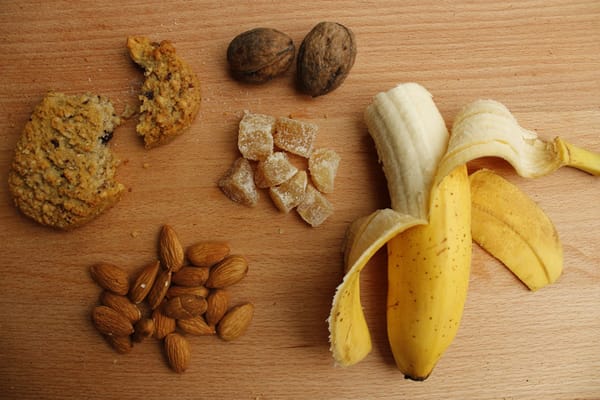How to Understand Your Food Cravings (and 5 Mindful Ways to Manage Them)

Everyone knows what it feels like to struggle through the mid-afternoon slump only to crave chocolate bars. Sometimes late night cravings for ice cream become too loud to resist. Food cravings may seem overpowering because they bring value to us.
Learning to pay attention to these signals about our self can expose valuable information on our body and our minds and our behaviors.
Rather than fighting cravings or feeling guilty, you can respond in ways that satisfy your needs while supporting your health goals. Let’s explore why cravings happen, what they might be trying to tell you, and 5 practical ways to navigate them mindfully.
Why Cravings Happen
Your body and brain use cravings to send signals into showing you need something or have an internal imbalance. Your body's ability to control your appetite depends heavily on hormones ghrelin (hormone promoting hunger) and leptin (hormone promoting satiety).
When these hormone systems become dysregulated through missed meals, lack of sleep or excessive stress, your craving levels create spikes.
Sometimes our desire to eat specific things reveals our body's need for certain nutrients. A person's need for magnesium might cause chocolate cravings while their emotional state yearns for its comfort.
Your body's lack of electrolytes can create salty cravings. Cravings never show pure simplicity because their underlying makeup combines physical factors and emotional elements.
Cravings emerge mainly because of stress levels and general exhaustion combined with specific emotional states. Cortisol levels help build up stress and also increase hunger while making high-fat foods more desirable. The brain releases dopamine in response to sugar, fast food, and salty ingredients to maintain a cycle of eating these foods repeatedly.
Our senses of smell and sight combined with social circumstances push our cravings higher through environmental influence. Lack of sleep makes cravings stronger because the brain searches for instant fuel.
Key Points:
- When you experience cravings it means your body or mind requires something.
- A lack of leptin or an excess of ghrelin hormones causes increased appetite.
- When you become stressed or tired your body trends toward calorie-dense foods.
- Your body's environmental triggers use sight and smell to activate food cravings.
Understanding Different Types of Cravings
Knowing how cravings express themselves enables you to manage them better. When you experience cravings they typically indicate a need that exists beyond mere desires to taste something. Cravings usually represent a physical, emotional, or psychological requirement you need to address.
Sweet Cravings: During stressful moments and midday energy drops, people most often experience sweet cravings. Your brain signals for quick glucose energy and your body demands dopamine to boost your emotional well-being.
When a candy bar pulls you in, choose instead a small bit of dark chocolate or a sweet snack from fruit to complete your craving without overwhelming yourself.
Salty Cravings: Your body drops its electrolyte count after physical exercise which then creates salty cravings. Instead of choosing processed chips, you can achieve satiety plus nutritional protein and healthy fats by eating lightly salted nuts, seeds, or roasted chickpeas.
Crunchy cravings: The desire for flavor plays less importance in crunchy food cravings than the matter of having a texture. The desire to snap, chew, or crunch something provides many people with sensory fulfillment.
You can satisfy your need for crunch by eating air-popped popcorn along with raw vegetables or whole grain crackers without consuming too many calories.
Creamy/fatty cravings: Creamy or fatty desires typically come from the need for comfort or fullness. Those who want nutrient-rich foods at the same time as a creamy texture should try avocado, yogurt, or nut butter.
You can also see Best Foods for Weight Loss: 25 Nutrient-Dense Options Backed by Science for ideas.
When people feel emotionally drained or physically tired, their cravings for creamy and rich foods intensify because these foods deliver both happiness and peace.
Key Points:
- Sweet cravings = energy or emotional comfort; consider fruit or dark chocolate.
- Salty cravings = possible electrolyte needs; try nuts, seeds, or roasted chickpeas.
- Crunchy cravings = desire for texture; raw vegetables or popcorn work well.
- Creamy/fatty cravings = stress relief or satiety; choose avocado, yogurt, or nut butter.
A clear understanding of craving type enables you to deliberately respond to cravings and stop you from eating without thinking.
Your Gut and Cravings
Health in your gut strongly affects which foods your body craves. The combined collection of trillions of intestinal bacteria known as the gut microbiome sends signals to your brain which influence both food preferences and appetite levels.
People who want sugary foods typically have certain sugar-loving bacteria which increase their cravings while an equalized gut microbiome naturally controls their appetite.
The health of your gut influences how you manage cravings so you should include fiber foods and fermented foods as well as proper hydration in your diet. After establishing a healthy gut your body will both weaken cravings and allow you to understand them better.
Key Points:
- Gut microbiome communicates with your brain, influencing cravings.
- Fiber-rich foods and fermented foods support healthy gut bacteria.
- Staying hydrated helps prevent confusing thirst with hunger.
Mindset and Behavioral Approaches: Setting the Foundation
(Focus: preparing your mind and environment to handle cravings better)
1. Shift Your Perspective on Cravings
The mental approach you take toward cravings significantly determines your response. When you view cravings as physical signals instead of mental challenges, you gain valuable information about your body alongside your emotions.
When you change your mindset, you decrease your stress while feeling less guilty and you gain control to make better health decisions.
2. Practice the Pause
Practice waiting whenever your body requests something. Detect which of the following three things normal craving responses represent: real hunger, emotional need, or environmental habits that become automatic.
This process supports your conscious evaluation before choosing what to do for food intake.
3. Reframe Negative Self-Talk
Replace your internal psychological conversation with fresh perspectives. Compare your "I shouldn't eat this" thoughts with a constructive comment stating that you see the craving but you have the intelligence to decide properly.
Repeated use of this strategy lowers your food-related anxiety and helps you establish confidence in your food choices.
4. Design a Supportive Environment
Your surroundings determine your eating behavior too. When you place nutritious foods within reach and hide non-nutritious foods, you will make healthful choices more automatic. Your body's cravings will show smaller intensity levels when you follow consistent meal schedules while getting sufficient sleep and managing your stress properly.
5. Build Consistent Habits
Small behavioral changes you should consider: your body signals become stronger and emotional or boredom-driven cravings decrease when you practice mindful eating, increase your hydration, and participate in physical activity you enjoy.
Key Points:
- Treat cravings as signals, not enemies.
- Pause and reflect before reacting.
- Reframe thoughts: notice cravings without judgment.
- Adjust your environment to make healthy choices easier.
- Maintain routine and self-care to reduce intense cravings.
5 Ways to Respond Mindfully to Cravings: Taking Action
(Focus: practical steps to follow when cravings actually happen)
Compassionate responses allow you to meet your bodily requirements without excess or shame. Many people find that these five approaches work when managing food cravings:
1. Pause and Check In
Take several deep breaths to determine whether the hunger you experience represents actual appetite, emotional reflex, or automatic response to your environment. A few minutes of stepping away and drinking some water will help you understand whether you need food or if a pause is enough.
Key Point: Pausing helps distinguish true hunger from impulsive urges.
2. Identify the Trigger
Understand what stimulus caused the craving to emerge. Various factors like stress and exhaustion, lack of engagement, exposure to food ads, and food-related marketing act as triggers for appetite stimulation.
Through journal keeping you will see eating patterns emerge during one week that helps you plan thoughtful responses later on.
Key Point: Recognizing triggers allows proactive, mindful responses.
3. Choose a Balanced Alternative
When your desire is authentic, pick an option that delivers both satisfaction and nutritional goodness. Examples include dark chocolate with roasted chickpea clusters, fruit, or nuts. Consider balanced alternatives.
Key Point: Smart alternatives meet cravings without guilt.
4. Engage in Mindful Eating
Make your eating experience slower and dedicate yourself fully to the moment when you consume food. Note the different tastes, sensations, and scents of your food. Mindful eating helps people enjoy food and stops them from eating too much.
Quick Takeaway: Mindful eating maximizes satisfaction and reduces mindless consumption.
5. Address Emotional Needs Directly
Sometimes our emotional state demands responses through food cravings. Instead of using food as a solution to your emotional needs, try breathing exercises, meditation, walks, hobbies, or light stretching exercises.
Your dependence on food for comfort will decrease as you develop these strategies.
Key Point: Meeting emotional needs directly reduces unnecessary snacking.
The Takeaway
Your body and brain send signals instead of showing weakness when they send you cravings. Your health goals stay intact when you listen carefully to your body and figure out triggers before making mindful responses to enjoy food guilt-free.
Mindful awareness transforms cravings from obstacles into insights about your nutrition, emotions, and habits. With time, you will see:
- Your body will need less spontaneous treat eating.
- Your meals will give you more pleasure.
- Your control of eating practices will strengthen.
- Your guilt associated with food will diminish.
The normality of cravings requires developing skills for thoughtful response. When you take conscious choices after thinking about your cravings, you build better food and body relationships.
Key Points:
- Listen to cravings as informative signals.
- Respond thoughtfully, not impulsively.
- Mindful eating and emotional awareness improve long-term habits.
- With continuity, cravings become essential guides to nutrition management and personal care.



